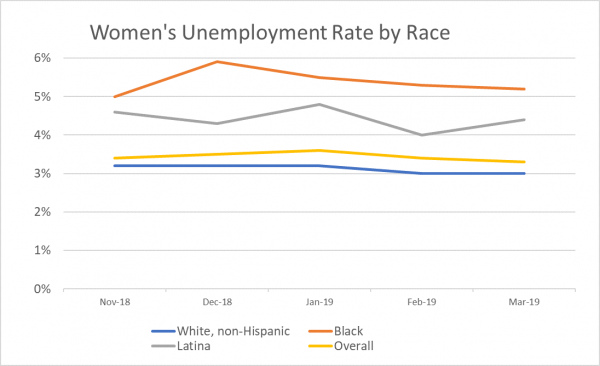Abortion rights, women of color, and LGBTQIA+ people are under attack. Pledge to join us in fighting for gender justice.
After Stalled Job Growth, Where do Women Workers Stand?

 The U.S. workforce has seen many ups and downs over the past few months. After a lengthy government shut down and stalled job growth in February (when the economy added just 20,000 jobs following several consecutive months of larger gains), the job market is in a bit of a flux. This is especially true for women and women of color, who face higher overall unemployment rates than white, non-Hispanic men.
The U.S. workforce has seen many ups and downs over the past few months. After a lengthy government shut down and stalled job growth in February (when the economy added just 20,000 jobs following several consecutive months of larger gains), the job market is in a bit of a flux. This is especially true for women and women of color, who face higher overall unemployment rates than white, non-Hispanic men.
The good news is that, according to BLS, women overall fared well during March. Women made up over two-thirds (68.4%) of the 196,000 jobs added to the economy and the unemployment rate for women only edged down slightly from 3.4% to 3.3%.
However, when women’s unemployment is broken down by race, the data tells a different story. Latina women’s unemployment rate increased from 4.0% in February to 4.4% in March while the unemployment rate for Black women decreased from 5.3% to 5.2%. These fluctuations in unemployment among women of color have been a consistent pattern over the past few months. Just take a look at this graph: while the unemployment rate for women overall and white, non-Hispanic women has remained steady since last November, the rate for Latina and Black women has fluctuated. The biggest jump occurred in Black women’s unemployment – they experienced almost a full percentage point increase in their unemployment rate from November to December. Not only that, but women of color consistently experience higher rates of unemployment that white, non-Hispanic women and women overall.

Further, this month’s BLS numbers show that unemployed Black and Latina women experience longer spells of unemployment. On average, unemployed Black and Latina women spent 29.2 and 23.4 weeks, respectively, looking for a new job compared to 20.4 weeks for white, non-Hispanic women and 22.5 weeks for women overall.
These figures indicate that women of color face multiple barriers to employment during many different points of job search process: Black and Latina women are more likely to be out of a job and experience the most difficulty finding work. Finding a job has only been made tougher by the tenuous nature of job growth over the past few months. Although some of March’s employment numbers were encouraging, we need to keep a close eye of the data to ensure that women – especially women of color – are not disproportionately affected by changes in the economy.
